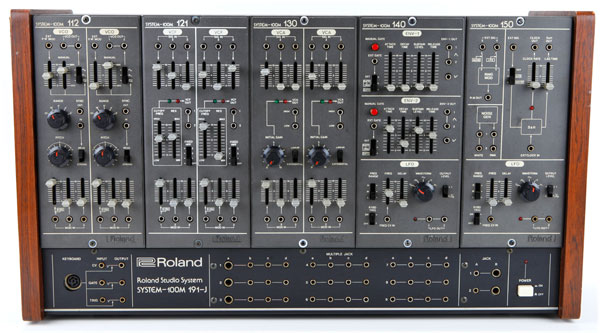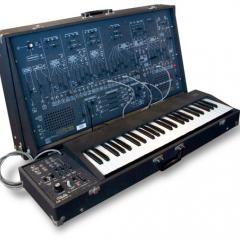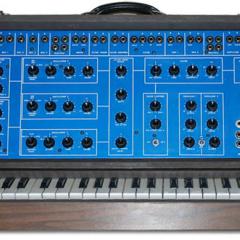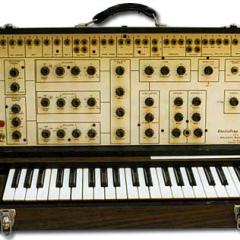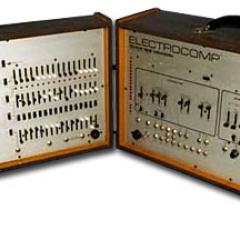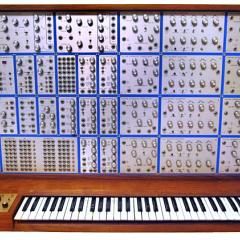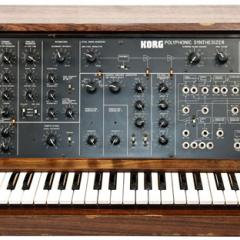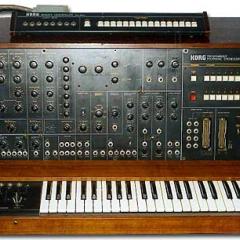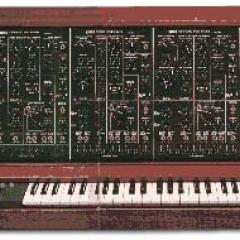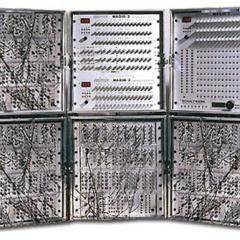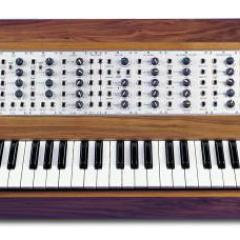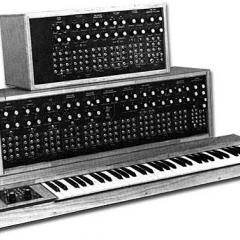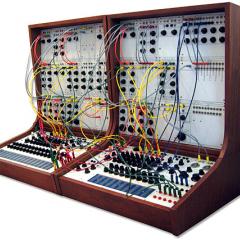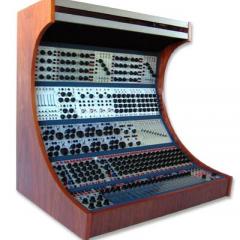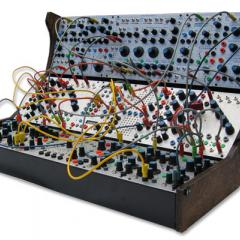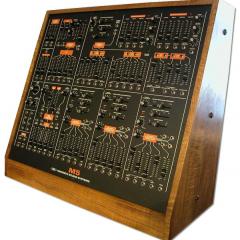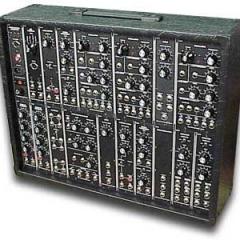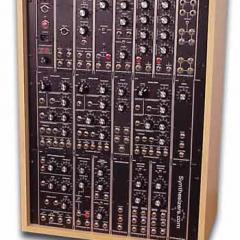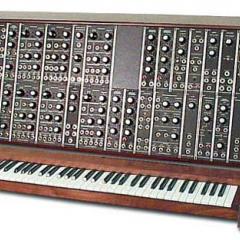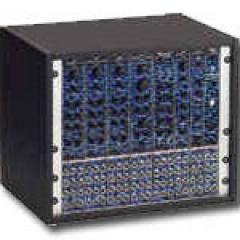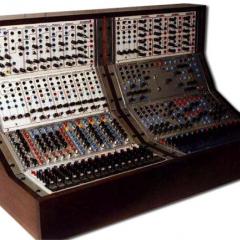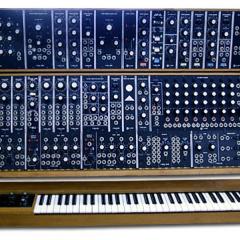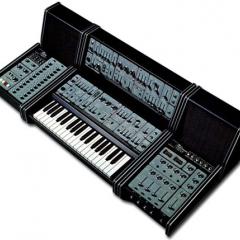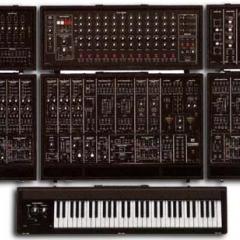Roland System 100m
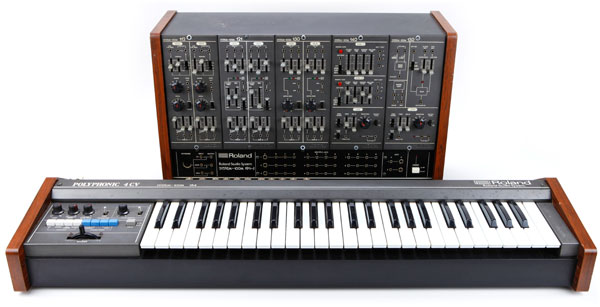
The System 100m is Roland's contribution to professional analog modular synthesis. It was based on the more limited, semi-modular System 100, but is several steps of ahead of its predecessor. The System 100m offers over 20 modular components to pick and choose to design a custom modular set-up. The Main unit is the M-110 which has a single VCO oscillator, VCF, and VCA section. You can then build upon this system adding any number and configurations of the various other modules which include dual VCOs, ring modulators, dual VCFs, eq, dual VCAs, dual envelopes, LFOs, various effects, mixers, sequencers, and control interfaces including 3 different keyboard controllers.
Modules are assembled into racks. The System 100m has 3 rack sizes, the M-190 holds 3 modules, the M-191 and M-191J hold 5 modules. Each rack provides the necessary 8-pin DIN power connectors and internal CV/gate connections between the modules. You still need to do some external patching, however, to send your signal through the modules of your choice to create any sounds. As for sounds, the System is basically monophonic, unless you get several racks of them for lots and lots of money! Its sound is not as warm as the System 100 before it, but it offers much more capability, as seen in Hans Zimmer's system below!
| Modules | Description |
|---|---|
| 110 | VCO single oscillator (with VCA and VCF sections) |
| 111 | VCO/VCF (unreleased prototype) |
| 112 | dual VCO, with 3 CV ins, 2 outs, and weak/strong sync |
| 120 | VCA (unreleased prototype) |
| 121 | dual VCF, with low-pass and high-pass filters with 24 dB/oct slope |
| 130 | dual VCA, with a linear/exponential switch |
| 131 | Mixer, 4 X 2 X 1, with panning and a tuning oscillator (220/440/880Hz) |
| 132 | dual Mixer and Voltage Processor |
| 140 | dual Envelope (ADSR, invertable, and manual gate button) and LFO (5 waveforms with switchable range: x1, x1/10) |
| 141 | dual Envelope, Gate Delay, and Invert/Adder |
| 150 | Ring Mod, Noise (pink and white), S&H (with lag), and LFO (5 waveforms with switchable range: x1, x1/10) |
| 160 | Computer Interface |
| 165 | Double Portamento Controller, with CV in |
| 170 | Pitch/Voltage Converter, Envelope Follower, and Audio Amp |
| 172 | Phase Shifter, Audio Delay, LFO, Gate Delay |
| 173 | Quadruple Signal Gate and six 4-way Multiples |
| 174 | Parametric Equalizer, four-band, with 20Hz to 20kHz center frequencies |
| 180 | Keyboard, 32-note (F-C) low note priority, with transpose switch and portamento knob |
| 181 | Keyboard, 49-note (C-C) same as 180 but with added portamento switch and bender lever (with CV out) |
| 182 | Analog Sequencer, 2 X 8 step, serial or parallel modes |
| 184 | Keyboard, 49-note (C-C) 4-voice, with switchable mono/polyphonic, an arpeggiator, and polyphonic portamento |
| 190 | three-module rack with connection sockets at the base |
| 190B | base unit that elevates the 190 above a keyboard |
| 191 | five-module rack |
| 191J | five-module rack with multiple connectors on its base |
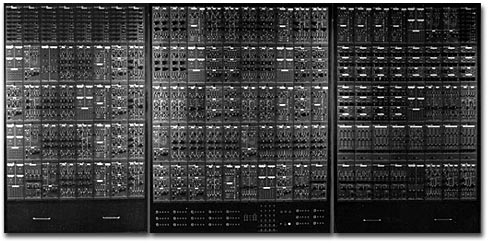
Hans Zimmer's massive System 100m, image and info courtesy of Kevin Lightner. "It features 58 VCOs, 37 VCFs, 32 ENVs, 12 VC Phase shifters, 9 Sequencers, 1 Remote controlled 4-space rack-mount power supply (25' away.), and 24 Trunk lines go to his large Moog synth across the room. The unit can link the "Keyboard" inputs for all the modules, and with this feature, all VCO's can track one input with only one patch cord. The unit was built into 6 flight cases on casters with removable front and rear covers, then later encased in wood and built into his studio. "----Kevin Lightner
System 100's have been used by Orbital, Hans Zimmer, Vince Clarke, Depeche Mode, Heaven 17, Freddy Fresh, Luke Vibert, Meat Beat Manifesto, Electronic Dream Planet, Jamiroquai, Human League, and Peter Howell of the BBC Radiophonic Workshop.
Demos & Media
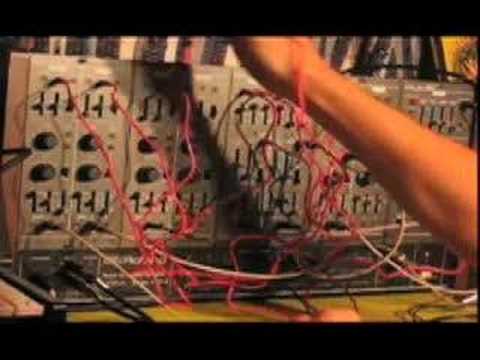
Specifications
M-110 VCO single oscillator (with VCA and VCF sections)
M-112 dual VCO, with 3 CV ins, 2 outs, and weak/strong sync
M-150 Ring Mod, Noise (pink and white), S&H (with lag), and LFO (5 waveforms with switchable range: x1, x1/10)
M-110 VCF (with VCO and VCA)
M-121 dual VCF, with low-pass and high-pass filters with 24 dB/oct slope
M-174 Parametric Equalizer, four-band, with 20Hz to 20kHz center frequencies
M-110 VCA (with VCO and VCF)
M-130 dual VCA, with a linear/exponential switch
M-140 dual Envelope (ADSR, invertable, and manual gate button) and LFO (5 waveforms with switchable range: x1, x1/10)
M-141 dual Envelope, Gate Delay, and Invert/Adder
M-180 Keyboard, 32-note (F-C) low note priority, with transpose switch and portamento knob
M-181 Keyboard, 49-note (C-C) same as M-180 but with added portamento switch and bender lever (with CV out)
M-184 Keyboard, 49-note (C-C) 4-voice, with switchable mono/polyphonic, an arpeggiator, and polyphonic portamento
M-170 Pitch/Voltage Converter, Envelope Follower, and Audio Amp
M-172 Phase Shifter, Audio Delay, LFO, Gate Delay
M-131 Mixer, 4 X 2 X 1, with panning and a tuning oscillator (220/440/880Hz)
M-132 dual Mixer and Voltage Processor
M-190 three-module rack with connection sockets at the base
M-190B base unit that elevates the 190 above a keyboard
M-191 five-module rack
M-191J five-module rack with multiple connectors on its base
M-160 Computer Interface
M-165 Double Portamento Controller, with CV in
M-173 Quadruple Signal Gate and six 4-way Multiples
Websites of Interest
Resources
Images from Perfect Circuit Audio and Kevin Lightner's Synthfool
